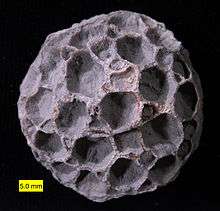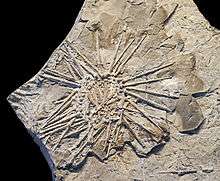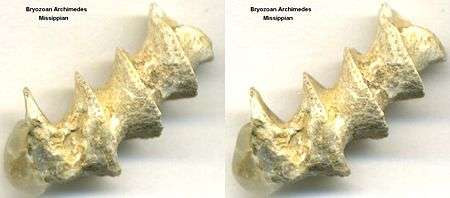Pitkin Formation
| Pitkin Formation Stratigraphic range: Upper Visean-Serpukhovian[1] | |
|---|---|
| Type | Formation |
| Sub-units | Imo Shale |
| Underlies | Hale Formation |
| Overlies | Fayetteville Formation |
| Thickness | up to and over 400 feet[2] |
| Lithology | |
| Primary | Limestone[1] |
| Other | Shale |
| Location | |
| Region | Arkansas |
| Country | United States |
| Type section | |
| Named for | Pitkin post office, Washington County, Arkansas[3] |
| Named by | George Irving Adams and Edward Oscar Ulrich |
The Pitkin Formation, or Pitkin Limestone, is a fossiliferous geologic formation in northern Arkansas that dates to the Chesterian Series of the late Mississippian.[4] This formation was first named the "Archimedes Limestone" by David Dale Owen in 1858, but was replaced in 1904.[3] The Pitkin conformably overlies the Fayetteville Shale and unconformably underlies the Pennsylvanian-age Hale Formation. Some workers have considered the top of the Pitkin Formation to be a separate formation called the Imo Formation. However more recently, others have considered it as an informal member of the Pitkin Formation.
Paleofauna
Early work aimed at creating a comprehensive list for all fossils found in the Pitkin Formation was done by Easton in 1943.[1] Unless otherwise stated, all species below can be found in his 'Fauna of the Pitkin Formation.'
Formanifera
Porifera, Sponges
Scyphozoa
- Conularia Originally considered to be a gstropod.
Anthozoa, Corals
|
|
 Aulopora from the Silica Formation of Ohio.
Aulopora from the Silica Formation of Ohio. Pleurodictyum americanum from the Givetian Kashong Shale (Hamilton Group) of Livingston County, New York.
Pleurodictyum americanum from the Givetian Kashong Shale (Hamilton Group) of Livingston County, New York. Syringopora from the Boone Formation of Arkansas.
Syringopora from the Boone Formation of Arkansas.
Blastoidea

Crinoidea, Sea Lilies
|
|
|
- Cyathocrinus goniodactylus, on display at Galerie de paléontologie et d'anatomie comparée in Paris.
- Fossil of Scytalocrinus from Carboniferous of the United States
Ophiuroidea, Brittle Stars
This group was originally place under Stelleroidia in early studies.[1]
- Aganaster
- A. singulatus
- Schoenaster
Echinoidea, Sea Urchins

Worms
Previous studies have grouped these diverse animals into a single, obsolete taxon: Vermes.[1]
Bryozoa, "Moss-animals"
| Stereo image | ||
| ||
| ||
| ||
| ||
| Fossilized skeleton of Archimedes Bryozoan. |
|
|
|
|
Brachiopoda
|
|
|
|
Bivalvia, Bivalves
This group was also referred to by another name in earlier studies: Pelecypoda.[1]
|
|
|
|
Scaphopoda, Tusk Shells
- Laevidentalium
Gastropoda, Snails
|
|
|
|
Cephalopoda
|
|
Trilobita
- Grifithides
- G. pustulosus
- Kaskia
- K. chesterensis
- K. pitkinensis[14]
- P. mucronatus
Ostracoda
- Glyptopleurain
- G. optina
- Paraparchites
- Primitia
- P. fayettevillensis
Vertebrata
Plantae, Plants
"Encrusting Algae" has been reported but not assigned to any genus.[1]
- Archaeolithophyllum[6]
- Asphaltina
- A. cordillerensis[5]
- Girvanella[5]
- Rectangulina[5]
Unidentified
Following is a list of fossils also found in the Pitkin by Easton in 1943 that have gone unidentified.[1]
- A "Cup Coral"
- A member of the genus Pentremites
- Three species within Agassizocrinus
- Two species within Scytalocrinus
- A totally unidentifiable Crinoid
- Two species of Bellerophon
- Two species of Gosseletina
- Two species of Leptoptygma
- Two Species of Strobeus
- One species each of Composita and Echinoconchus
- Two species of Cypricardella
- Two species of Coloceras, one of which may actually be Leuroceras
- One species of Dolorthoceras
- An unnamed shark spine
See also
References
- 1 2 3 4 5 6 7 8 9 10 11 12 13 14 15 16 17 18 19 20 21 22 23 24 25 26 27 28 29 30 31 32 33 34 35 36 37 38 39 Easton, William H., The Fauna of the Pitkin Formation of Arkansas., Journal of Paleontology: vol. 17:2. March, 1943.
- ↑ McFarland, John David (2004) [1998]. "Stratigraphic summary of Arkansas" (PDF). Arkansas Geological Commission Information Circular. 36: 12–13.
- 1 2 Adams, G.; Ulrich, E. (1904). "Zinc and lead deposits of northern Arkansas". U.S. Geological Survey Professional Paper. 24: 27, 109.
- ↑ Various Contributors to the Paleobiology Database. "Fossilworks: Gateway to thefix Paleobiology Database". Archived from the original on 31 July 2014. Retrieved 8 July 2014.
- 1 2 3 4 5 6 7 8 9 10 11 12 13 14 15 16 17 18 19 20 21 22 Brenckle, Paul (1977). "Foraminifers and other calcareous microfossils from Late Chesterian (Mississippian) strata of northern Arkansas" (PDF). Oklahoma Geological Survey Guidebook. 18: 73–87. Retrieved 3 February 2018.
- 1 2 3 4 5 6 Nodine-Zeller, Doris E. (1977). "Microfauna from Chesterian (Mississippian) and Morrowan (Pennsylvanian) rocks in Washington County, Arkansas, and Adair and Muskogee Counties, Oklahoma" (PDF). Oklahoma Geological Survey Guidebook. 18: 89–99. Retrieved 3 February 2018.
- 1 2 3 4 Webb, Gregory., 1987., The Coral Fauna of the Pitkin Formation (Chesterian), Northeastern Oklahoma and Northwestern Arkansas. Journal of Paleontology vol. 61:3
- 1 2 Webb., Gregory., 1990., A New Tabulate Coral Species from the Pitkin Formation (Chesterian) of north-central Arkansas. Journal of Paleontology vol. 64:4.
- 1 2 3 4 Horowitz, Alan S.; Macurda Jr, D. B. (1977). "Late Mississippian and Early Pennsylvanian blastoids from northeastern Oklahoma and northwestern Arkansas" (PDF). Oklahoma Geological Survey Guidebook. 18: 169–170. Retrieved 31 January 2018.
- 1 2 3 4 5 6 7 8 9 10 11 12 13 14 15 16 17 18 19 20 21 22 23 24 Strimple, Harrell L. (1977). "Chesterian (Upper Mississippian) and Morrowan (Lower Pennsylvanian) crinoids of northeastern Oklahoma and northwestern Arkansas" (PDF). Oklahoma Geological Survey Guidebook. 18: 171–176. Retrieved 30 January 2018.
- 1 2 3 4 5 6 7 8 9 10 11 12 13 14 15 16 17 18 19 20 21 22 23 24 25 26 27 28 29 30 31 32 33 34 35 Horowitz, Alan S. (1977). "Late Mississippian and Early Pennsylvanian bryozoan faunas of Arkansas and Oklahoma: a review" (PDF). Oklahoma Geological Survey Guidebook. 18: 101–105. Retrieved 3 February 2018.
- ↑ Henry, Thomas W.; Gordon Jr., Mackenzie (January 1985). "Chesterian davidsoniacean and orthotetacean brachiopods, Ozark region of Arkansas and Oklahoma". Journal of Paleontology. 59 (1): 32–59. JSTOR 1304826.
- 1 2 3 4 5 6 Saunders, W. Bruce; Manger, Walter L.; Gordon Jr., Mackenzie (1977). "Upper Mississippian and Lower and Middle Pennsylvanian ammonoid biostratigraphy of northern Arkansas" (PDF). Oklahoma Geological Survey Guidebook. 18: 117–137. Retrieved 1 February 2018.
- ↑ Brezinski, David K. (31 March 2017). "Some New Late Mississippian Trilobites from Oklahoma and Arkansas". Annals of Carnegie Museum. 84 (2): 173–178. doi:10.2992/007.084.0203.

